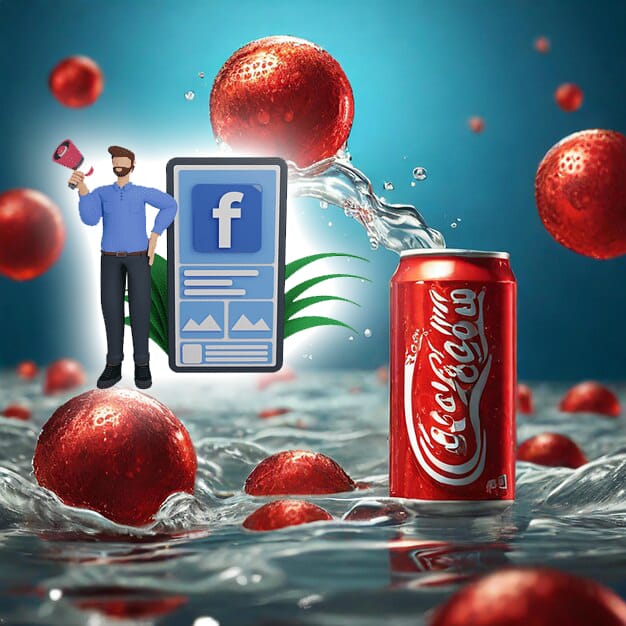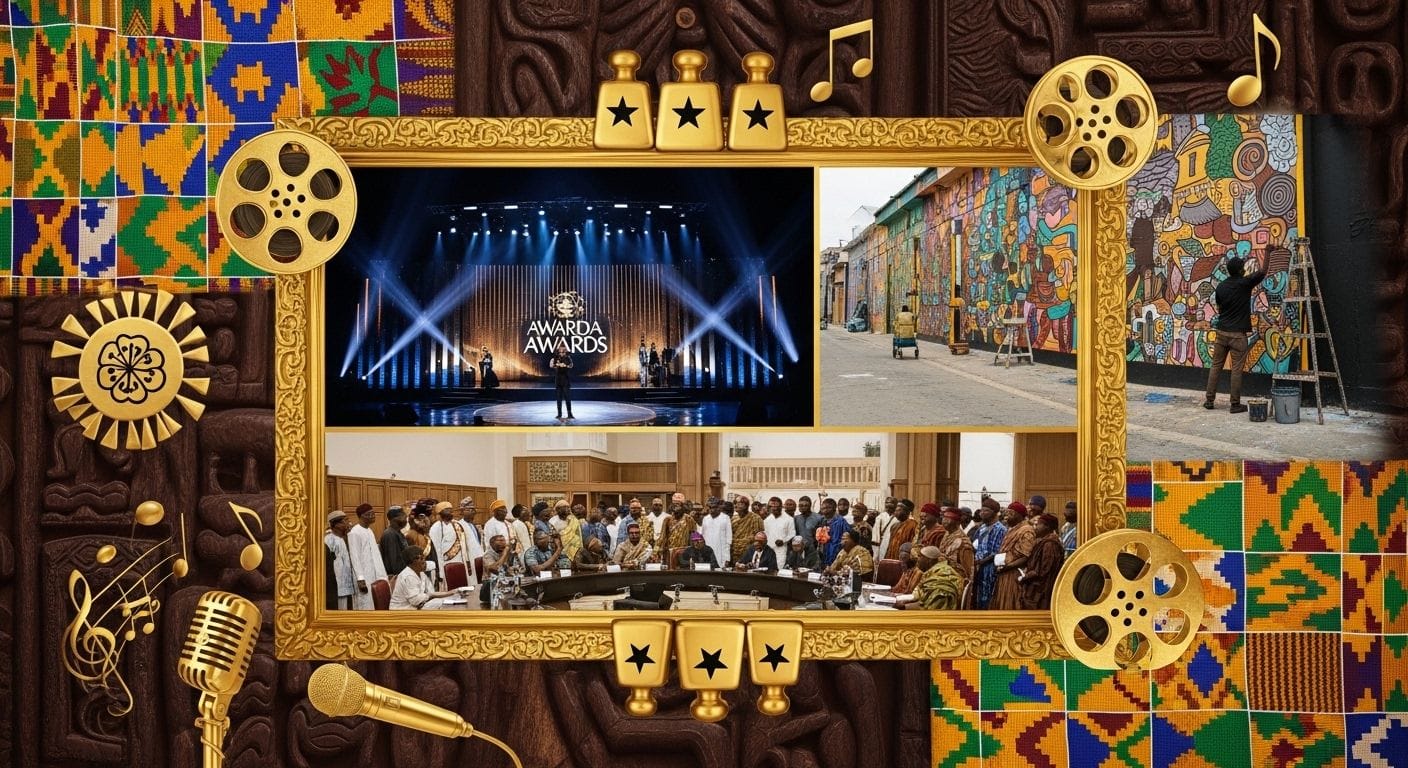Coca-Cola has leveraged Facebook advertising to reach millions, increase brand awareness, drive conversions, and boost revenue. Even a well-known brand like Coca-Cola needs to maintain customer engagement to ensure consumers don’t lose interest. By analyzing Coca-Cola’s Facebook ad campaigns, businesses can learn from their successes and failures.
Podcast
Coca-Cola’s Objectives
- Brand Awareness: Coca-Cola used Facebook ad campaigns to raise brand awareness.
- Product Sales: Facebook ads were used to drive sales of Coca-Cola products.
- Targeting Specific Demographics: Coca-Cola used Facebook to reach specific audiences, like young adults.
- Promoting in Emerging Markets: Coca-Cola used Facebook advertising to promote its products in emerging markets like Kenya.
- Promoting New Products: When Coca-Cola launched a special series of Aluminum Bottles, it used a Canvas ad on Facebook, reaching nearly 16 million people.
Coca-Cola’s Facebook Ad Campaigns
Enjoy the Feeling (South Africa)
- Launched in 2016 as a cross-media brand repositioning campaign.
- Used video ads, carousels, and canvas formats on desktop and mobile devices.
- Revolved around the hashtag #EnjoyTheFeeling and featured compelling stories.
- Increased individual reach by 42% with only 3.5% of the budget.
- Boosted brand impact and campaign reach by 96%.
- Facebook advertising proved to be three times more cost-effective than TV advertising.
Coca-Cola Life (Brazil)
- Aimed at promoting Coca-Cola Life, a lower-sugar, lower-calorie beverage.
- Targeted 18–34-year-olds through a two-phase campaign:
- Product Discovery and Recognition: Built brand awareness.
- Boosting Product Sales: Encouraged purchases.
- Reached 77% of the target audience.
- Increased favorability for Coca-Cola Life by 8 points among Facebook users.
- Increased product recall by 6 points.
Kenyan Happiness (Kenya)
- Focused on increasing brand recognition in Kenya.
- Featured photos of Kenyans enjoying Coke.
- Used the hashtag #KenyanHappiness to encourage user-generated content.
Aluminum Bottle Campaign
- Used Facebook’s Canvas ads to promote a new Aluminum Bottle series.
- Reached nearly 16 million people.
- Incorporated videos and photos detailing the creation process.
Share a Coke Campaign (Australia)
- Personalized Coke bottles with 150 of Australia’s most popular names.
- Allowed users to:
- Share a virtual Coke with friends via Facebook ads.
- Create custom Coke ads using Facebook photos.
- Participate in the Coke Unleashed competition.
Lessons from Coca-Cola’s Facebook Ads
- Engagement: Encouraged customers to buy more Coke to collect letters and spell messages.
- Positive Messaging: Incorporated videos and messages of positive social change.
- Event Sponsorship: Sponsored One World: #TogetherAtHome to honor COVID-19 frontline workers.
- Consistency: Reinforced campaigns by replicating Facebook ad imagery on its website.
- Charity Support: Partnered with Big Brothers and Big Sisters of Canada, donating $0.50 per selected beverage purchased.
- Building Trust: Showed Sustainability Practices by supporting the #CanadaPlasticsPact.
Coca-Cola’s Marketing Diversification
- Expanding into products like Fairlife milk, BodyArmor, and Simply Light juices.
- Adapting to declining soda consumption trends since 2002.
- Focusing on alternative beverages like bottled water, juices, teas, and coffees.
Key Factors of Coca-Cola’s Success
- Personalization: Customized Coke bottles to create emotional connections.
- Social Media Engagement: Used hashtags like #ShareACoke to track user-generated content and engage directly with consumers.
- Targeted Marketing: Adapted campaigns to specific demographics and cultures.
- Compelling Ads: Created engaging, colorful, and emotionally driven Facebook ads.
- Localized Positioning: Featured regional celebrities and culturally relevant messages.
Broader Marketing Strategies
- Targets a wide audience, leading to strong brand recognition.
- Appeals to:
- Young people (ages 10-35): Uses celebrities and university campaigns.
- Middle-aged and older consumers: Offers diet and alternative beverage options.
- Uses various pricing strategies by offering different sizes and packages.
- Adapts marketing to different countries, cultures, and climates.
- Implements both personal and non-personal marketing channels:
- Non-personal channels: Newspapers, television, webpages, and social media.
- Follows the 4Ps of Marketing: Product, Place, Price, and Promotion.
- Invests up to $4 million annually in advertising.
- Uses classic branding elements: font, logo, and bottle design.
- Engages in sponsorships, including Olympic events.
Coca-Cola’s Strengths
- Strong Brand Identity: Brand strength index of 93.3 out of 100.
- Strong Brand Value: Valued at $97.7 billion.
- Global Reach: Sells in over 200 countries and serves approximately 1.9 billion people daily.
- Emotional Brand Association: Customers feel a deep emotional connection with Coca-Cola.
Coca-Cola’s Weaknesses
- Competition with Pepsi: Pepsi remains a major rival.
- Limited Product Diversification: Pepsi has expanded into food and snacks, while Coca-Cola has a narrower focus.
- Health Concerns: Energy drinks are linked to health issues like diabetes and obesity.
Podcast Transcript
Welcome back everybody to another deep dive. Today, we’re gonna be looking at Coca Cola and all the marketing magic that has made this brand so iconic. Yeah. They really are everywhere you look. Yeah.
So, I mean, beyond the jingles and the polar bears, what what is it that makes their marketing tick? Well, you know, when you consider they sell 1,800,000,000 bottles a day, it really makes you wonder. One twenty eight billion. Yeah. Every day.
That’s a lot of soda. With that kind of reach, you’d think advertising wouldn’t even be necessary. You would. But that’s where the story gets really interesting. Because even at that scale, consistent marketing is crucial.
It’s all about staying relevant, keeping people engaged, of course, reaching those new audiences. I mean, it’s true what they say. Right? Out of sight, out of mind. Even Coca Cola can’t just rest on its laurels.
Exactly. A perfect example of this is their hashtag enjoy the feeling campaign in South Africa. They actually managed to boost their reach by 42% even with a smaller budget. Oh, wow. That’s pretty impressive.
How did they manage that? Well, they tapped into something really powerful, emotions. They used storytelling across multiple platforms, video image galleries, even those immersive mobile ads, you know, the ones that take up your whole screen. Oh, yeah. It wasn’t just about the product.
It was about creating an experience. Devoking a feeling. Exactly. And they’ve used that same approach in other markets with some pretty amazing results. For example, when they launched Coca Cola Life in Brazil, they used a really smart two phase strategy.
Okay. I’m intrigued, Ymir. First, they focused on just building awareness, getting people curious. Then they hit their target audience, young adults, with ads specifically designed to drive sales. So different ads for different stages of the campaign.
Exactly. And the results speak for themselves. They reached seven times more people than they would have with just traditional TV ads. Wow. Seven times.
That’s incredible. It really makes you wonder if traditional media even has a place anymore. Well, I think traditional media still has its role. But there’s no denying that digital platforms offer a level of targeting and impact that’s hard to beat, especially when you factor in personalization. Right.
And speaking of personalization, we have to talk about share a Coke. I mean, that campaign was everywhere. Who hasn’t looked for their name or a friend’s name on a Coke bottle? It was brilliant, really. Such a simple concept, but so effective.
They understood that people love that personal touch. It makes you feel like you’re part of something special. And it wasn’t just about finding your own name. It was about sharing it with others, posting it on social media. They turned their customers into marketers.
Exactly. User generated content at its finest. It kept the campaign fresh and engaging, and they didn’t stop there. They got even more strategic with different variations for different groups. Like how?
Well, for teens, they use labels like BFF, you know, tapping into that whole friendship thing. And for sports fans, they had bottles with team logos. It was all about creating a sense of community and belonging. It’s amazing how they managed to personalize something on such a massive scale. It really shows how much thought they put into understanding their audience.
Absolutely. They’re not just throwing spaghetti at the wall and seeing what sticks. They’re constantly analyzing data, refining their approach, and finding new ways to connect. Makes sense. You know, all this talk about Coke is making me thirsty.
Yeah. But Coca Cola isn’t just about sugary drinks anymore, is it? They’ve been branching out quite a bit. You’re right. Soda consumption has been declining for years, so they’ve had to adapt.
They’ve expanded into other beverage categories, juices, sports drinks, even milk and bottled water. It’s a smart move from a business perspective. But I’m curious. What does this tell us about their Global Marketing Strategy? I think it shows they’re willing to adapt and evolve.
They’re not afraid to try new things and stay ahead of the trends. They understand that to stay relevant, they need to meet the changing needs of their customers. It’s a good lesson for any business, really. You can’t just sit back and expect things to stay the same. You have to be willing to embrace change and keep innovating.
Couldn’t agree more. And it also shows a commitment to meeting a wider range of consumer needs and preferences. It’s not just about selling more soda. It’s about providing options that fit different lifestyles. So they’re not just adapting to survive.
They’re adapting to thrive. Exactly. Exactly. But even for a giant like Coca Cola, it’s not always easy. They’ve faced their fair share of challenges, especially when it comes to the environment.
Right. You can’t talk about Coca Cola without addressing those concerns about water usage and plastic waste. It’s been a major point of contention. It’s a complex issue, and they’ve been under a lot of pressure to improve their sustainability practices. They’ve taken some steps in the right direction, investing in water conservation and exploring more sustainable packaging It’s a tough balancing act, though.
Right? Yeah. Maintaining growth while also being environmentally responsible? It’s a challenge that a lot of companies are facing. It’s a challenge that’s not going away anytime soon, and it’ll be interesting to see how they continue to navigate this complex landscape.
Well, it’s clear that Coca Cola’s marketing is a multifaceted beast. They’ve mastered the art of emotional connection, personalization, and adapting to a changing world. But we’ve only just scratched the surface. There’s so much more to uncover. There is.
When we come back, we’ll dive even deeper into some of their most iconic campaigns and the secrets behind their enduring success. Stay tuned. Welcome back to our deep dive. You know, we were just talking about Sharecoke before the break. Such a clever campaign.
It really was. It felt so personal, so unique. What do you think were the key ingredients to its success? Well, for me, it was that feeling of being singled out in a good way. Like, they made a bottle just for me.
Exactly. They tapped into that human desire for recognition, that feeling of being special, and then they took it a step further. Right. It wasn’t enough to just find your own name. You had to find your friend’s name Mhmm.
Your mom’s name, your dog’s name. Yeah. It became a game. It did. And it was a game that everyone could play.
It was brilliant marketing, really. They turned their customers into brand ambassadors. And they didn’t just stop at names, did they? They expanded it with all sorts of themes and variations. Oh, yeah.
They understood that different people connect with different things. So they created versions for everyone. Teens, sports fans, you name it. Like those BFF bottles for teenagers. Exactly.
Or the ones with team logos for sports fans. They were really smart about segmenting their audience and tailoring the message. It’s impressive how they managed to create something that felt both personal and universal at the same time. It’s a delicate balance, but they pulled it off. And they proved that even in today’s world of mass marketing, you can still create genuine connections with individual consumers.
Well, let’s move on from soda for a bit and talk about Coca Cola’s expansion into other beverage categories. It’s a fascinating evolution, isn’t it? It is. I mean, they’ve gone from just soda to offering everything from juice and water to plant based milk alternatives. They had to adapt.
Soda consumption has been declining for years, and they recognize that they couldn’t just rely on their core products. Makes sense. Mhmm. But how have they managed to maintain their brand identity while venturing into all these different categories? It’s a testament to their strong brand equity and their ability to leverage their core values.
Yeah. You know, things like happiness, connection, refreshment. Those themes run through all their products. So even though they’re offering different types of drinks, the underlying message is still the same. Exactly.
And they’ve been very strategic about how they’ve rolled out these new products, making sure that they align with their overall brand image. It’s like they’ve taken their core essence and expanded it to encompass a wider range of products and lifestyles. That’s a great way to put it. They’re not just chasing trends. They’re creating them.
They’re shaping the future of the beverage industry. It’s impressive. But let’s not forget that they’ve also faced some challenges along the way, especially when it comes to their environmental impact. Oh, absolutely. The controversy surrounding water usage and plastic waste have been a major headache for them.
It’s a tough issue, and they’ve been under a lot of pressure to improve their sustainability practices. They have. And to be fair, they have made some progress investing in water conservation programs and exploring more sustainable packaging options. But there’s still a long way to go. Right?
There is. It’s a complex problem with no easy solutions, but it’s something that they and every other major corporation need to address. Consumers are becoming more and more aware of these issues, and they’re demanding that companies take responsibility. That’s right. It’s not just about profits anymore.
It’s about doing business in a way that’s sustainable and ethical. Well, this has been a fascinating look at the evolution of Coca Cola’s business. Mhmm. But let’s get back to their marketing for a moment. What are some of the specific tactics and strategies they’ve used to achieve such incredible success?
Well, one of their key strengths has always been their visual branding. Just think about their logo, the red and white color scheme, the contoured bottle shape. It’s instantly recognizable. It is. They’ve created a visual language that transcends language barriers and cultural And they’ve been consistent with it over the years.
Consistency is key in branding. It builds trust and recognition. And they’ve also been smart about evolving their visual identity while staying true to their core essence. Like how they incorporated personalized names into the share a Coke campaign. Exactly.
They kept their iconic script and color palette, but added that element of personalization. It was a brilliant way to freshen up their image while staying true to their roots. They’ve also been masters at evoking emotions through their marketing. Oh, absolutely. Their holiday commercials are a classic example.
They tap into those warm fuzzy feelings associated with family and togetherness. It’s not just about selling a product. It’s about selling a feeling. Exactly. And they’ve been incredibly effective at storytelling.
Uh-huh. They’ve used everything from real people to animated polar bears to connect with their audience on a human level. They’ve also embraced the power of digital marketing, haven’t they? Oh, yeah. They were early adopters social media influencer Mhmm.
Marketing, content marketing. They’re constantly experimenting with new platforms and technologies. Like they have their finger on the pulse of the digital world. They do. And they’re not afraid to try new things.
They understand that the digital landscape is constantly changing, and they need to adapt to stay ahead of the curve. This deep dive has been incredibly insightful. We’ve learned so much about Coca Cola’s marketing strategies and their evolution as a brand. We have. But there’s one crucial aspect we haven’t touched on yet, their approach to global marketing.
Right. How do they tailor their message for different cultures and regions around the world? Well, that’s a story for another time. Stay tuned because when we come back, we’ll delve into the fascinating world of Coca Cola’s global marketing strategy. Welcome back to our deep dive.
Now before the break, we’re talking about Coca Cola’s global marketing strategy. It’s a fascinating topic, isn’t it? I mean, they’re everywhere you look. They really are. So how do they manage to tailor their message for all those different cultures and countries?
Well, they’ve adopted what’s called a global strategy. Basically, it means think globally, act locally. Okay. I think I understand. So they have a global vision, but they adapt it for each specific market.
Exactly. They understand that some things are universal like the Coca Cola logo and their core values of happiness and connection, but the way those things are expressed needs to resonate with the local culture. Can you give us an example of how they do that? Sure. Think about their advertising campaigns.
In some regions, they might focus on family gatherings and celebrations, While others, they might emphasize individual enjoyment or friendships. It all depends on the cultural values of that particular market. So it’s about finding that sweet spot between global consistency and local relevance. Exactly. And they don’t just stop at translating their ads.
They also use local talent and resources whenever possible. Oh, that’s interesting. So they might work with local artists or filmmakers. Exactly. It helps to ensure that their campaigns feel authentic and relatable to the local audience.
That makes a lot of sense. It’s not just about talking to people. It’s about connecting with them on a deeper level. And it goes beyond advertising too. They also tailor their product offerings and packaging to suit local tastes and preferences.
So you might find a different flavor of Coke in one country than you you would in another. Exactly. Or the packaging might be different or the size of the bottles. It’s all about adapting to the local market. It’s a pretty impressive approach.
It shows a real commitment to understanding and respecting different cultures. It does. And it’s been a key factor in their global success. But, of course, operating on a global scale also comes with its fair share of challenges. Like what?
Well, for starters, there’s the political and economic volatility of different regions. They have to be very careful to avoid any controversies or missteps that could damage their brand. Right. Because something that might be considered acceptable in one culture could be offensive in another. Exactly.
And then there’s the challenge of managing their online presence in a globalized world. Oh, yeah. Social media can be a minefield for global brands. It can. One wrong move, and you could face a massive backlash.
So they have to be extra careful about what they say and do online. They do. They need to be constantly monitoring social media and responding to any potential issues that arise. Well, it’s clear that global marketing is no walk in issues that arise. Well, it’s clear that global marketing is no walk in the park, but Coca Cola seems to have navigated these challenges pretty well.
They have. They’ve shown us that it’s possible to build a truly global brand while still respecting and celebrating the diversity of cultures around the world. This has been a truly fascinating deep dive. We’ve learned so much about Coca Cola’s marketing strategies from their iconic campaigns to their global expansion. It’s been a pleasure sharing these insights with you.
And hopefully, our listeners have learned a thing or two about what it takes to build a successful brand. Absolutely. No matter what industry you’re in or what size your business is, there’s always something to learn from the best. So go out there and make some marketing magic. Thanks for listening, everyone.











